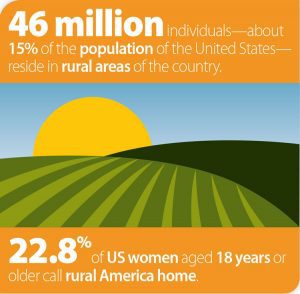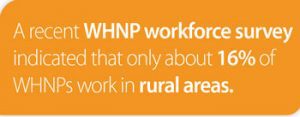Approximately 46 million individuals—about 15% of the population of the United States—reside in rural areas of the country.1 A slightly larger proportion, 22.8%, of US women aged 18 years or older call rural America home.2 For all rural residents, top priorities set forth by Healthy People 2020 include increasing access to primary care services, emergency department (ED) services, and insurance coverage.3 Rural women, when compared with their urban counterparts, experience more disparities in terms of primary care and reproductive healthcare.1 Although the need for specialists in women’s healthcare is particularly evident in rural areas, few such healthcare providers (HCPs) cover these areas.3 Nurse practitioners (NPs), including women’s health nurse practitioners (WHNPs), can help reduce health disparities, improve access to care, and promote favorable health outcomes for female rural residents.
Rural women’s health concerns and barriers
Compared with women residing in urban areas, those residing in rural areas experience higher rates of poverty.4 According to the most recent estimates from the 2017 American Community Survey (ACS), the nonmetro area poverty rate was 16.4%, compared with 12.9% for metro areas.5 In addition, educational achievement is lower in rural communities than in urban communities, with fewer residents completing high school and even fewer completing college.4,6 Furthermore, inadequate or no health insurance coverage and inferior healthcare access are major problems in rural communities.1,6,7
Higher rates of smoking, sedentary lifestyles, obesity, and hypertension are more common among rural citizens than those of urban America, thereby predisposing rural populations to specific health problems.1 Women living in rural communities, compared with their urban counterparts, have an excess of chronic health problems and are more likely to die of heart disease, chronic lower respiratory disease, stroke, cancer, and unintentional injuries.1 In addition, when rural patients are hospitalized, they routinely lack adequate follow-up because of a shortage of primary care providers (PCPs) and because of poor communication between the discharging hospital providers and rural PCPs, which can lead to more frequent ED visits and possibly rehospitalization.1 Compared with urban Medicare patients, rural Medicare patients discharged from hospitals have fewer follow-up visits and more ED visits.8
 Reproductive health disparities exist among women in rural America. Rural women are less likely than urban women to engage in preventive health services such as cervical cancer and breast cancer screenings.1 Cervical cancer mortality rates are higher in rural women as well.9 With regard to younger females, rates of sexually transmitted infections among rural teens are higher than those among urban teens.10 The incidence of unplanned and teen pregnancy rates in rural communities exceed those of urban communities.10,11 National census data suggest that higher rates of reproductive health disparities may be due to increased poverty, lower education levels, and reduced health insurance access.12 Although many rural HCPs prescribe combination hormonal contraceptives and the contraceptive injection, only a few place long-acting reversible contraceptives (an implant or an intrauterine device)—the most effective reversible contraceptive options available.11
Reproductive health disparities exist among women in rural America. Rural women are less likely than urban women to engage in preventive health services such as cervical cancer and breast cancer screenings.1 Cervical cancer mortality rates are higher in rural women as well.9 With regard to younger females, rates of sexually transmitted infections among rural teens are higher than those among urban teens.10 The incidence of unplanned and teen pregnancy rates in rural communities exceed those of urban communities.10,11 National census data suggest that higher rates of reproductive health disparities may be due to increased poverty, lower education levels, and reduced health insurance access.12 Although many rural HCPs prescribe combination hormonal contraceptives and the contraceptive injection, only a few place long-acting reversible contraceptives (an implant or an intrauterine device)—the most effective reversible contraceptive options available.11
Compared with urban women, rural women encounter more health disparities related to obstetrics care access and outcomes.13 Delays in beginning prenatal care in rural areas occur because of the lack of HCPs who accept Medicaid and the length of time needed to get approved for Medicaid services if they are provided.14 Fewer than half of US rural counties offer hospital-based obstetrics services.15 Breastfeeding education, including that provided by culturally competent PCPs with breastfeeding experience, is also lacking in rural communities, resulting in low rates of breastfeeding.16 The fact that more than half of rural obstetrics patients must travel more than 30 minutes for care may contribute to increased risks for infant mortality, pregnancy complications, and maternal mortality in rural areas.13 Data indicate that maternal and infant mortality rates are higher in rural versus urban areas.15
WHNPs in rural communities: Filling a need
Fewer than one-third of physicians in the United States provide primary care, and among these primary care physicians, more than 90% work in urban rather than rural settings.14,17,18 Rural America also has an insufficient number of HCPs to offer prenatal and obstetrics services.13 When WHNPs and other PCPs join interprofessional practices in the rural setting, everyone benefits. Solo physicians and staff report improved job satisfaction when an NP is added to the practice.19 Rural family practices are twice as likely as nonrural practices to employ an NP.20 In a 2012 NP job satisfaction analysis, most rural NPs reported that they performed within their scope of practice to the fullest extent.21 Highest levels of satisfaction came from the proportion of time spent in patient care, level of autonomy, and the respect they received from colleagues.21 When NPs are part of the practice, patients enjoy improved access to care, with increased appointment availability.21 Patients with chronic diseases cared for by physician/NP collaborators tend to be better managed and experience fewer ED visits and hospital admissions.19,20
WHNPs are uniquely suited to provide care to rural women. WHNPs are prepared to provide care for women across the lifespan, with an emphasis on reproductive, obstetric, gynecologic, and primary care. In addition, they provide reproductive and sexual healthcare for men.22
WHNPs working in rural America: Rewards and challenges
Working in rural communities poses challenges to WHNPs who heed the call. Some rural communities share a value wherein health and illness are defined based on whether a person can work or not.23 Therefore, preventive services may not be a priority. In some respects, rural practice settings have both challenges and benefits, in that providers see friends, neighbors, and family members as patients. Because many rural PCPs live in the community in which they practice, they are likely to understand patients’ values and viewpoints firsthand. This understanding can facilitate shared decision making. At the same time, PCPs may find that confidentiality and privacy are challenging when everyone knows each other in a community.23
Two WHNPs working in rural Alabama provide personal insights into the rewards and challenges. AH states, “Serving rural populations has been the highlight of my career as a WHNP. As the only women’s HCP in the rural clinical site, I had the opportunity to provide care to females across the lifespan. It was exhausting but rewarding work. The lack of resources made it challenging.” AB shares, “It is rewarding to provide much-needed care to the female population. Anticipatory guidance and health instruction to women mean a lot more than they did even 30 years ago. Education can be challenging because of food deserts, transportation issues, and other resource challenges. It is more difficult to encourage healthful eating, along with other important lifestyle recommendations, when affordable options are lacking.”
A recent WHNP workforce survey indicated that only about 16% of WHNPs work in rural areas.24 Various incentive programs are available for NPs who provide primary care to work in rural areas. The Health Resources and Service Administration (HRSA) offers the advanced nursing education workforce grants that support advanced nursing education for registered nurses training to become primary care NPs.25 In addition, HRSA provides the National Health Service Corps scholarship and loan repayment program for HCPs working in health professional shortage areas.26 Finally, many state nursing organizations provide scholarships to advanced nursing education in addition to loan repayment opportunities for working in rural settings.26
Currently, 21 states and the District of Columbia have approved full practice authority allowing NPs to assess, diagnose, and treat patients independently.27 Rural NPs need to determine whether their state’s scope of practice laws may hinder them from practicing to the fullest extent of their education and preparation. They also need to collaborate with organizations to foster policy initiatives to improve access to care. In addition, WHNPs working in rural areas should be able to obtain a DNP degree. DNP programs prepare WHNPs to be nursing leaders, health policy advocates, and clinical experts who can drive quality improvement. They can be the change agents needed to improve health for rural women. =
Lisa S. Pair is Assistant Professor, Ashley L. Hodges is Associate Professor, and Aimee C. Holland is Associate Professor, all at the University of Alabama at Birmingham School of Nursing. The authors state that they do not have a financial interest in or other relationship with any commercial product named in this article.
References
- CDC. Rural health. Updated August 2, 2017. cdc.gov/ruralhealth/about.html.
- Xue Y, Smith JA, Spetz J. Primary care nurse practitioners and physicians in low-income and rural areas, 2010-2016. JAMA. 2019;321(1):102-105.
- ACOG Committee opinion no. 586: health disparities in rural women. Obstet Gynecol. 2014;123(2 pt 1):384-388.
- Bolin JN, Bellamy GR, Ferdinand AO, et al. Rural healthy people 2020: new decade, same challenges.
J Rural Health. 2015;31(3):326-333. - United States Department of Agriculture. Rural poverty & well-being. Updated March 25, 2019. ers.usda.gov/topics/rural-economy-population/rural-poverty-well-being/.
- Temkin SM, Rimel BJ, Bruegl AS, et al. A contemporary framework of health equity applied to gynecologic cancer care: a society of gynecologic oncology evidenced-based review. Gynecol Oncol. 2018;149(1):70-77.
- Agency for Healthcare Research and Quality. 2014 National Healthcare Quality and Disparities Report. AHRQ Pub. No. 15-0007. Rockville, MD: Agency for Healthcare Research and Quality; May 2015.
- Toth M, Holmes M, Van Houtven C, et al. Rural Medicare beneficiaries have fewer follow-up visits and greater emergency department use post discharge.
Med Care. 2015;53(9):800-808. - Henley SJ, Anderson RN, Thomas CC, et al. Invasive cancer incidence, 2004-2013, and deaths, 2006-2015, in nonmetropolitan and metropolitan counties — United States. MMWR Surveill Summ. 2017;66(no. SS-14):1-13.
- Eaton DK, Kann L, Kinchen S, et al. Youth risk behavior surveillance – United States, 2011. MMWR Surveill Summ. 2011:61(4):1-162.
- Lunde B, Smith P, Grewal M, et al. Long acting contraception provision by rural primary care physicians.
J Womens Health (Larchmt). 2014;23(6):519-524. - Women’s Health USA 2013. Health services utilization. Rockville, MD: U.S. Department of Health and Human Services, 2013. https://mchb.hrsa.gov/whusa13/health-services-utilization.html.
- Hung P, Henning-Smith CE, Casey MM, Kozhimannil KB. Access to obstetric services in rural counties still declining, with 9 percent losing services, 2004-14. Health Affairs (Millwood). 2017;36(9):1663-1671.
- Madler B, Helland M. Establishing a viable workforce pipeline of primary care nurse practitioners: benefits of a health system and academic partnership. Nurs Adm Q. 2017;41(1):20-28.
- Thomson JL, Tussing-Humphreys LM, Goodman MH, Olender S. Baseline demographic, anthropometric, psychosocial, and behavioral characteristics of rural, southern women in early pregnancy. Matern Child Health J. 2016;20(9):1980-1988.
- Allen JA, Perrine CG, Scanlon KS. Breastfeeding supportive hospital practices in the US differ by county urbanization level. J Hum Lact. 2015:31(3):440-443.
- Petterson S, McNellis R, Klink K, et al. The State of Primary Care in the United States: A Chartbook of Facts and Statistics. Washington, DC: Agency for Healthcare Research and Quality and the Robert Graham Center; January 2018.
- National Organization of State Offices of Rural Health. About Rural Health in America. Sterling Heights, MI: NOSORH; June 9, 2018.
- Roots A, MacDonald M. Outcomes associated with nurse practitioners in collaborative practice with general practitioners in rural settings in Canada: a mixed methods study. Hum Resour Health. 2014;12:69.
- Peterson LE, Blackburn B, Petterson S, et al. Which family physicians work routinely with nurse practitioners, physician assistants or certified nurse midwives. J Rural Health. 2014;30(3):227-234.
- Bae SH. Nurse practitioners’ job satisfaction in rural versus nonrural areas. J Am Assoc Nurse Pract. 2016;28(9):471-478.
- National Association of Nurse Practitioners in Women’s Health/Association of Women’s Health, Obstetric and Neonatal Nurses. Women’s Health Nurse Practitioner: Guidelines for Practice and Education. 7th ed. Washington, DC: NPWH/AWHONN; 2014.
- Nelson WA, Barr PJ, Castaldo MG. The opportunities and challenges for shared decision-making in the rural United States. HEC Forum. 2015;27(2):157-170.
- National Association of Nurse Practitioners in Women’s Health. 2018 NPWH Women’s Health Nurse Practitioner Workforce Demographics and Compensation Survey: highlights report. November 12, 2019. https://www.npwomenshealthcare.com/2018-npwh-womens-health-nurse-practitioner-workforce-demographics-and-compensation-survey-highlights-report/.
- Health Resources & Services Administration. HRSA Health Workforce. Nursing. Advanced nursing education workforce grant. bhw.hrsa.gov/grants/nursing.
- Health Resources & Services Administration, National Health Service Corps. Loan repayment. nhsc.hrsa.gov/loan-repayment/index.html.
- American Association of Nurse Practitioners, Campaign for Action. State practice environment for nurse practitioners. campaignforaction.org/resource/state-practice-environment-nurse-practitioners/.

